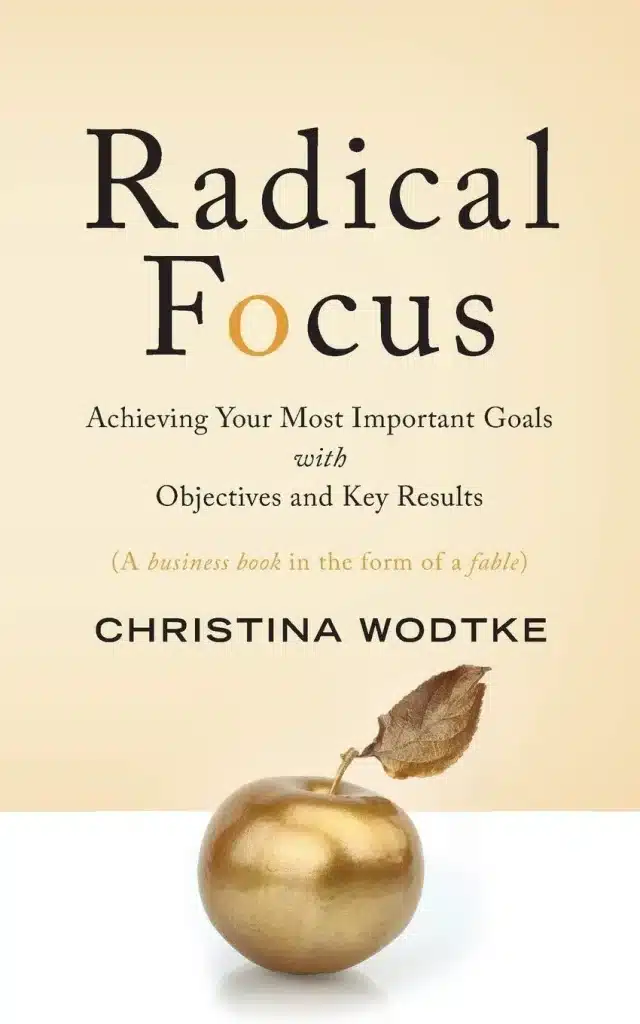How can you inspire a diverse bunch of people to strive and achieve a challenging task?
How do you keep yourself driven in the face of failures and frustration?
And what do you do if it seems that you’re on the verge of failing?
You read Radical Focus by Christina Wodtke! The author has disguised an insightful book for every entrepreneur in the form of an intriguing tale.

Christina Wodtke uses her hard-won expertise as an executive at Zynga, Linkedin, and a slew of other Silicon Valley hotspots to answer those questions in Radical Focus. It’s just not about the to-do lists and graphs of accountability.
It’s all about establishing a system for regular check-ins, significant results, and, most importantly, the beauty of a good failure – and how to turn a short setback into a future triumph. In this book, Wodtke walks you through the fictional case study of Hanna and Jack, two entrepreneurs who are battling to make ends meet.

They battle shiny object syndrome, lose focus, and have communication problems. They learn the practical measures they need to do what needs to be done after unpleasant lessons. The second half of the book shows how to use Objectives and Key Results (OKRs) to help teams achieve big goals in a systematic, risk-free manner.

She lays out the lessons of Hanna and Jack’s narrative in a practical but fascinating manner, making them obvious and applicable.
So, are you now ready to get your team moving in the correct direction? Read this to discover the strategy for focusing on your goals and achieving success.
Key Takeaways on OKRs from Radical Focus
As the title of the book implies, Wodtke promotes the use of OKRs to develop concentration and ensure that the essential objectives are met.
1. Key Results are measurable and quantitative
Each Objective will have three quantitative Results that indicate when you’ve achieved your goal. Key Results, according to Wodtke, are “challenging targets that you only have a 50/50 chance of accomplishing.”

2. OKRs vs. health measurements
Wodtke offers a useful difference between OKRs and health measures throughout the book. OKRs are “the one item you want to improve, the one you want to push.” We’d emphasise the word “one” here since we believe that focusing on a single company goal is the most effective. Multiple corporate objectives, start to muddy the water in terms of focus and prioritisation. Instead, one should by establishing a single company goal. Secondly, assign OKRs to each team that relate to the company’s overall goal.

3. The goals are ambitious and high-quality
Each quarter, make a bold, inspiring, and qualitative goal. Wodtke gives examples of both good and bad goals.
4. Set OKRs as a group and choose Key Results as a group
The process of identifying and agreeing on Objectives and Key Results is a team effort. A vital first step is to clearly articulate and share the business objective. The various teams can then set the Key Results that they believe would help them achieve the company goal.
5. Setting an execution rhythm
Wodtke provides a number of weekly rituals that you may use to keep your OKRs relevant and on track. The danger with goal-setting is that it becomes a one-time event, and I feel that holding weekly ‘commitment’ and ‘victory’ meetings will aid in keeping OKRs in mind.
6. Progress tracking
We liked Wodtke’s suggestion of using a 4×4 matrix to track progress towards reaching the team OKRs. This matrix is a quick and easy approach to commit to (weekly) priorities and track your progress.

Final Word
Christina Wodtke does an excellent job of discussing the significance and usefulness of OKRs in her book “Radical Focus.” Not only does Wodtke offer helpful advice on how to define OKRs, but she also discusses how to track progress against them.
Christina Wodtke’s approach to writing “Radical Focus,” which employs storytelling to explain the goal-setting theory behind OKRs, is a refreshing approach to management research.
While your team begins the collaborative establishment of your own OKRs, we hope that you keep referring to the events and learn from the characters in the book.






